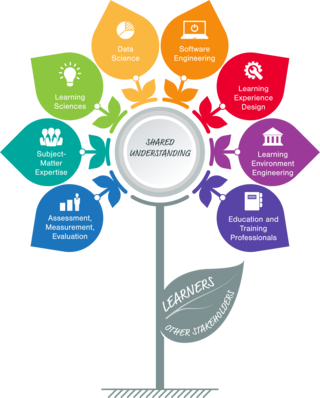Related Research Articles
Computational linguistics is an interdisciplinary field concerned with the computational modelling of natural language, as well as the study of appropriate computational approaches to linguistic questions. In general, computational linguistics draws upon linguistics, computer science, artificial intelligence, mathematics, logic, philosophy, cognitive science, cognitive psychology, psycholinguistics, anthropology and neuroscience, among others.
Computer-assisted language learning (CALL), British, or Computer-Aided Instruction (CAI)/Computer-Aided Language Instruction (CALI), American, is briefly defined in a seminal work by Levy as "the search for and study of applications of the computer in language teaching and learning". CALL embraces a wide range of information and communications technology applications and approaches to teaching and learning foreign languages, from the "traditional" drill-and-practice programs that characterised CALL in the 1960s and 1970s to more recent manifestations of CALL, e.g. as used in a virtual learning environment and Web-based distance learning. It also extends to the use of corpora and concordancers, interactive whiteboards, computer-mediated communication (CMC), language learning in virtual worlds, and mobile-assisted language learning (MALL).
In artificial intelligence, symbolic artificial intelligence is the term for the collection of all methods in artificial intelligence research that are based on high-level symbolic (human-readable) representations of problems, logic and search. Symbolic AI used tools such as logic programming, production rules, semantic nets and frames, and it developed applications such as knowledge-based systems, symbolic mathematics, automated theorem provers, ontologies, the semantic web, and automated planning and scheduling systems. The Symbolic AI paradigm led to seminal ideas in search, symbolic programming languages, agents, multi-agent systems, the semantic web, and the strengths and limitations of formal knowledge and reasoning systems.
A cognitive tutor is a particular kind of intelligent tutoring system that utilizes a cognitive model to provide feedback to students as they are working through problems. This feedback will immediately inform students of the correctness, or incorrectness, of their actions in the tutor interface; however, cognitive tutors also have the ability to provide context-sensitive hints and instruction to guide students towards reasonable next steps.
A learning management system (LMS) is a software application for the administration, documentation, tracking, reporting, automation, and delivery of educational courses, training programs, materials or learning and development programs. The learning management system concept emerged directly from e-Learning. Learning management systems make up the largest segment of the learning system market. The first introduction of the LMS was in the late 1990s. Learning management systems have faced a massive growth in usage due to the emphasis on remote learning during the COVID-19 pandemic.
An intelligent tutoring system (ITS) is a computer system that aims to provide immediate and customized instruction or feedback to learners, usually without requiring intervention from a human teacher. ITSs have the common goal of enabling learning in a meaningful and effective manner by using a variety of computing technologies. There are many examples of ITSs being used in both formal education and professional settings in which they have demonstrated their capabilities and limitations. There is a close relationship between intelligent tutoring, cognitive learning theories and design; and there is ongoing research to improve the effectiveness of ITS. An ITS typically aims to replicate the demonstrated benefits of one-to-one, personalized tutoring, in contexts where students would otherwise have access to one-to-many instruction from a single teacher, or no teacher at all. ITSs are often designed with the goal of providing access to high quality education to each and every student.
Project LISTEN was a 25-year research project at Carnegie Mellon University to improve children's reading skills. Project LISTEN. The project created a computer-based Reading Tutor that listens to a child reading aloud, corrects errors, helps when the child is stuck or encounters a hard word, provides hints, assesses progress, and presents more advanced text when the child is ready. The Reading Tutor has been used daily by hundreds of children in field tests at schools in the United States, Canada, Ghana, and India. Thousands of hours of usage logged at multiple levels of detail, including millions of words read aloud, have been stored in a database that has been mined to improve the Tutor's interactions with students. An extensive list of publications can be found at Carnegie Mellon University.
Natural-language programming (NLP) is an ontology-assisted way of programming in terms of natural-language sentences, e.g. English. A structured document with Content, sections and subsections for explanations of sentences forms a NLP document, which is actually a computer program. Natural language programming is not to be mixed up with natural language interfacing or voice control where a program is first written and then communicated with through natural language using an interface added on. In NLP the functionality of a program is organised only for the definition of the meaning of sentences. For instance, NLP can be used to represent all the knowledge of an autonomous robot. Having done so, its tasks can be scripted by its users so that the robot can execute them autonomously while keeping to prescribed rules of behaviour as determined by the robot's user. Such robots are called transparent robots as their reasoning is transparent to users and this develops trust in robots. Natural language use and natural-language user interfaces include Inform 7, a natural programming language for making interactive fiction, Shakespeare, an esoteric natural programming language in the style of the plays of William Shakespeare, and Wolfram Alpha, a computational knowledge engine, using natural-language input. Some methods for program synthesis are based on natural-language programming.
Informatics is the study of computational systems. According to the ACM Europe Council and Informatics Europe, informatics is synonymous with computer science and computing as a profession, in which the central notion is transformation of information. In other countries, the term "informatics" is used with a different meaning in the context of library science, in which case it is synonymous with data storage and retrieval.
Adaptive learning, also known as adaptive teaching, is an educational method which uses computer algorithms as well as artificial intelligence to orchestrate the interaction with the learner and deliver customized resources and learning activities to address the unique needs of each learner. In professional learning contexts, individuals may "test out" of some training to ensure they engage with novel instruction. Computers adapt the presentation of educational material according to students' learning needs, as indicated by their responses to questions, tasks and experiences. The technology encompasses aspects derived from various fields of study including computer science, AI, psychometrics, education, psychology, and brain science.
Social media language learning is a method of language acquisition that uses socially constructed Web 2.0 platforms such as wikis, blogs, and social networks to facilitate learning of the target language. Social media is used by language educators and individual learners that wish to communicate in the target language in a natural environment that allows multimodal communication, ease of sharing, and possibilities for feedback from peers and educators.

A pedagogical agent is a concept borrowed from computer science and artificial intelligence and applied to education, usually as part of an intelligent tutoring system (ITS). It is a simulated human-like interface between the learner and the content, in an educational environment. A pedagogical agent is designed to model the type of interactions between a student and another person. Mabanza and de Wet define it as "a character enacted by a computer that interacts with the user in a socially engaging manner". A pedagogical agent can be assigned different roles in the learning environment, such as tutor or co-learner, depending on the desired purpose of the agent. "A tutor agent plays the role of a teacher, while a co-learner agent plays the role of a learning companion".
Vincent Aleven is a professor of human-computer interaction and director of the undergraduate program at Carnegie Mellon University's Human–Computer Interaction Institute.
Cognitive computing (CC) refers to technology platforms that, broadly speaking, are based on the scientific disciplines of artificial intelligence and signal processing. These platforms encompass machine learning, reasoning, natural language processing, speech recognition and vision, human–computer interaction, dialog and narrative generation, among other technologies.
This glossary of artificial intelligence is a list of definitions of terms and concepts relevant to the study of artificial intelligence, its sub-disciplines, and related fields. Related glossaries include Glossary of computer science, Glossary of robotics, and Glossary of machine vision.
Argument technology is a sub-field of artificial intelligence that focuses on applying computational techniques to the creation, identification, analysis, navigation, evaluation and visualisation of arguments and debates. In the 1980s and 1990s, philosophical theories of arguments in general, and argumentation theory in particular, were leveraged to handle key computational challenges, such as modeling non-monotonic and defeasible reasoning and designing robust coordination protocols for multi-agent systems. At the same time, mechanisms for computing semantics of Argumentation frameworks were introduced as a way of providing a calculus of opposition for computing what it is reasonable to believe in the context of conflicting arguments.

Bruce Martin McLaren is an American researcher, scientist and author. He is an Associate Research Professor at Carnegie Mellon University and a former President of the International Artificial Intelligence in Education Society (2017-2019).

Learning Engineering is the systematic application of evidence-based principles and methods from educational technology and the learning sciences to create engaging and effective learning experiences, support the difficulties and challenges of learners as they learn, and come to better understand learners and learning. It emphasizes the use of a human-centered design approach in conjunction with analyses of rich data sets to iteratively develop and improve those designs to address specific learning needs, opportunities, and problems, often with the help of technology. Working with subject-matter and other experts, the Learning Engineer deftly combines knowledge, tools, and techniques from a variety of technical, pedagogical, empirical, and design-based disciplines to create effective and engaging learning experiences and environments and to evaluate the resulting outcomes. While doing so, the Learning Engineer strives to generate processes and theories that afford generalization of best practices, along with new tools and infrastructures that empower others to create their own learning designs based on those best practices.
References
- 1 2 3 4 5 Contemporary computer-assisted language learning. Thomas, Michael, 1969-, Reinders, Hayo., Warschauer, Mark. London: Bloomsbury Academic. 2012. ISBN 978-1-4411-1300-9. OCLC 820029337.
{{cite book}}: CS1 maint: others (link) - 1 2 3 Gamper, Johann; Knapp, Judith (2002). "A Review of Intelligent CALL Systems". Computer Assisted Language Learning. 15 (4): 329–342. doi:10.1076/call.15.4.329.8270. ISSN 0958-8221. S2CID 11814439.
- 1 2 Bontogon, Megan; Arppe, Antti; Antonsen, Lene; Thunder, Dorothy; Lachler, Jordan (2018). "Intelligent Computer Assisted Language Learning (ICALL) for nêhiyawêwin : An In-Depth User-Experience Evaluation". Canadian Modern Language Review. 74 (3): 337–362. doi:10.3138/cmlr.4054. ISSN 0008-4506. S2CID 149711542.
- ↑ Sentance, Susan (1993). Recognising and responding to English article usage errors : an ICALL based approach. ed.ac.uk (PhD thesis). University of Edinburgh. hdl:1842/20176. OCLC 605993412. EThOS uk.bl.ethos.661745.

- 1 2 3 4 5 6 7 8 9 Heift, Trude. (2007). Errors and intelligence in computer-assisted language learning : parsers and pedagogues. Schulze, Mathias, 1962-. New York: Routledge. ISBN 978-0-203-01221-5. OCLC 191541349.
- 1 2 Matthews, Clive (1993). "Grammar Frameworks in Intelligent CALL". CALICO Journal. 11 (1): 5–27. doi:10.1558/cj.v11i1.5-27. S2CID 60842088.
- 1 2 Shaalan 1, Khaled F (2005). "An Intelligent Computer Assisted Language Learning System for Arabic Learners". Computer Assisted Language Learning. 18 (1–2): 81–109. doi:10.1080/09588220500132399. ISSN 0958-8221.
- 1 2 3 4 5 6 Höhn, Sviatlana (2019-06-21). Artificial companion for second language conversation : chatbots support practice using conversation analysis. Cham, Switzerland. ISBN 978-3-030-15504-9. OCLC 1105896323.
- ↑ Chen, Nancy F.; Wee, Darren; Tong, Rong; Ma, Bin; Li, Haizhou (2016-11-01). "Large-scale characterization of non-native Mandarin Chinese spoken by speakers of European origin: Analysis on iCALL". Speech Communication. 84: 46–56. doi: 10.1016/j.specom.2016.07.005 . ISSN 0167-6393.
- 1 2 3 4 Bailin, Alan; Levin, Lori (1989). "Introduction: Intelligent Computer-Assisted Language Instruction". Computers and the Humanities. 23 (1): 3–11. doi:10.1007/BF00058765. ISSN 0010-4817. JSTOR 30204410. S2CID 64307424.
- ↑ Attali, Yigal; Burstein, Jill (2006-02-01). "Automated Essay Scoring With e-rater® V.2". The Journal of Technology, Learning and Assessment. 4 (3). ISSN 1540-2525.